Estimated reading time: 14 minutes
In this article, you’ll dive deeply into the top 7 advantages of game-based learning within the classroom, understand what differentiates it from gamification, and discover which types of games are better for today’s kids.
Table of contents
- Gamification vs Game-Based Learning: What’s the Difference?
- 7 Advantages of Game-based Learning Strategies
- 1. Game-Based Learning Increases Engagement and Enjoyment
- 2. GBL Enables a Safe Environment for Failure
- 3. Game-based Learning Enables Immediate Feedback
- 4. GBL Improves Problem-Solving Skills
- 5. Game-Based Learning Enhances Memory and Retention
- 6. GBL Promotes Active Participation
- 7. It’s an Amazing Tool To Raise Test Scores
- Games vs. traditional learning tools, according to Dr. Gee
- Types of game-based learning
- A game-based learning platform for Schools & Districts!
According to the latest National Assessment of Educational Progress (NAEP) data from October 2022, an alarming decline in math proficiency is evident– a drop of 5 points in fourth grade and 8 points in eighth grade compared to 2019.
While educators and district administrators underscore the need for innovative solutions that help restore growth in test scores, game-based learning platforms emerge as a powerful solution.
Research from Vanderbilt University suggests that increased student engagement leads to better information absorption and retention.
Keep reading to understand why school and district leaders are turning to game-based learning to boost academic performance.
Gamification vs Game-Based Learning: What’s the Difference?
Game-based learning (GBL) and gamification are guided by the same overarching principle: morphing a traditional classroom task into a more engaging, competitive activity.
Gamification applies game-like elements like points, badges, and leaderboards to non-game situations. Imagine a classroom where students earn points for completing assignments and move up a leaderboard.
This is gamification in action. The core learning material (assignments) remains the same, but the game elements add a layer of fun and competition.
Using actual games to teach new concepts is one of the advantages of game-based learning because, after all, players learn through the gameplay itself.
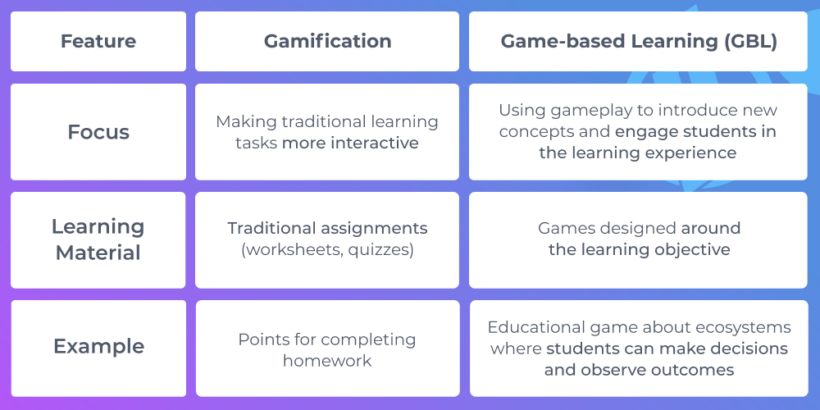
Some good examples:
- Educational games where students learn about ecosystems by playing as a creature in that ecosystem.
- Exploring historical events through a role-playing game. In GBL, the game is the learning experience.
Even though they are distinct approaches, both gamification and GBL share a common goal: making learning more engaging and effective. Next time you evaluate educational technology, consider the difference between these two approaches!
Learn more about Legends of Learning for Schools and Districts
7 Advantages of Game-based Learning Strategies
While traditional learning methods can struggle to ignite student engagement, game-based learning harnesses our inherent desire for play and competition.
These interactive experiences transform passive learners into active participants, navigating immersive worlds and making choices that impact the learning journey. This fosters a deeper connection to the material and fuels motivation through a rewards and challenges system.
These are the 7 key advantages of game-based learning strategies for schools:
1. Game-Based Learning Increases Engagement and Enjoyment
Certainly, games make learning fun and interactive, keeping students engaged and motivated. But how come?
Students struggling with traditional methods like reading textbooks or memorizing facts benefit from the interactive nature and varied challenges that games aligned by design can provide.
This also prevents boredom and keeps all students excited about learning new things. Many games even allow players to make choices that affect the storyline or gameplay fostering a deeper connection to the material.
Not to mention that elements like reward points, badges, and leaderboards create a strong sense of accomplishment that motivates kids to keep learning and progressing through the game.
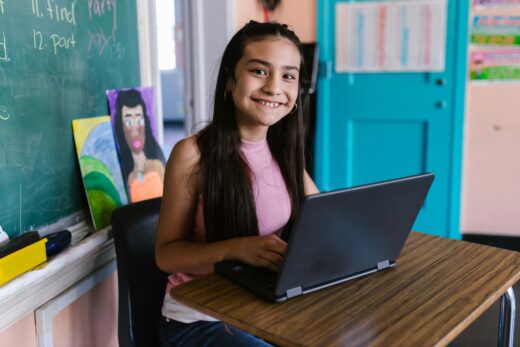
2. GBL Enables a Safe Environment for Failure
Game-based learning strategies allow mistakes without real-world consequences. During the game, a safe space is created for students to experiment, learn from their errors, and improve without feeling discouraged.
Provided that many games offer multiple attempts or built-in checkpoints, players can learn from their mistakes and try again without restarting the entire activity.
Students can also celebrate small victories and progress, building confidence as they overcome challenges at their own pace. This fosters perseverance and encourages students to keep trying until they succeed.
3. Game-based Learning Enables Immediate Feedback
Games often provide players with immediate outcomes, allowing them to identify and correct their mistakes quickly and easily.
Whereas correct answers and successful task completion are often rewarded, mistakes offer opportunities to learn and try again.
The constant feedback loop keeps students engaged in learning, adjusting their strategies, and improving their understanding.
4. GBL Improves Problem-Solving Skills
Games often require players to think critically and solve problems to advance, making them a great deal to develop valuable problem-solving skills and resilience in the face of challenges.
Some even present students with increasingly complex problems and puzzles to solve. These challenges require players to think critically, analyze information, and apply their knowledge to find solutions.
As the game progresses, the difficulty level increases, pushing them to develop more sophisticated problem-solving skills.
In addition, strategic decisions are often required, and players need to weigh options, consider consequences, and adapt their plans based on new information.
Game-based learning experiences that involve teamwork and collaboration bring students to share their ideas and communicate effectively to achieve a common goal.
5. Game-Based Learning Enhances Memory and Retention

Games can help students remember information better than traditional methods. Unlike passive learning methods like lectures, games require students to participate actively in the learning process.
They connect with the material by making choices, solving problems, and navigating the game world. This active engagement strengthens neural pathways and leads to better information retention.
Moreover, game-based learning strategies rely upon spaced repetition techniques, where games present information at progressively increasing intervals to optimize memorization.
Audio, visuals, and even kinesthetic elements (through movement-based games) are key elements in games. This multi-sensory approach leads to deeper information processing and improved memory retention.
Games’ narratives and storylines often connect students emotionally to the learning material, making information more meaningful and memorable. Historical events revisited through interactive simulations are a good example.
6. GBL Promotes Active Participation
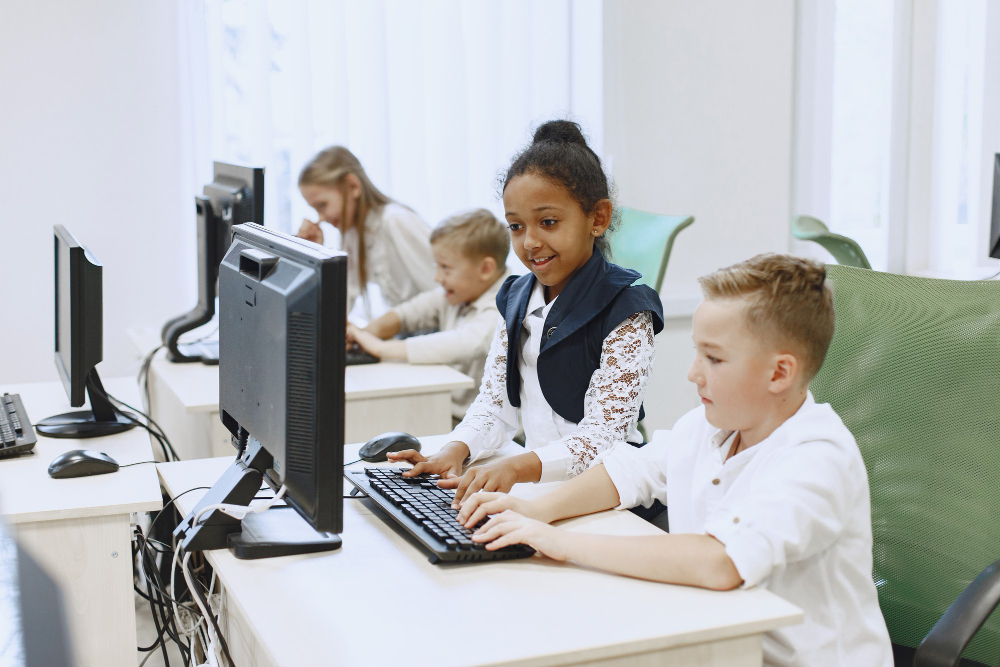
One of the key advantages of game-based learning is how this method inspires students to actively participate in their learning process.
Students get to make choices and influence the learning journey by selecting characters, customizing settings, or deciding on actions that impact the game’s narrative or gameplay.
Certainly, challenges that may arise often require active participation to succeed and make it to the end.
Furthermore, many games incorporate elements of competition, either individually or in teams. Students strive to outperform their peers, achieve high scores, or complete tasks within a time limit. A healthy competition that significantly fuels motivation!
On the other hand, we have educational games that promote collaboration, requiring students to work together, share strategies, and communicate effectively to achieve a common goal.
7. It’s an Amazing Tool To Raise Test Scores
A rigorous, curriculum-aligned game-based learning strategy can raise test scores by making learning fun and engaging. GBL fosters better focus, stronger memory, and sharper problem-solving skills – all essential ingredients for test success.
To be effective, games need to be well-designed and aligned with learning objectives, and assessments must be configured to capture the skills learned through games.
Some EdTech companies have innovated moving beyond gamification into true game-based learning meticulously crafting engaging games targeting a specific learning standard. This ensures that the skills and knowledge students gain while plating align directly with the state curriculum.
Proven by Research
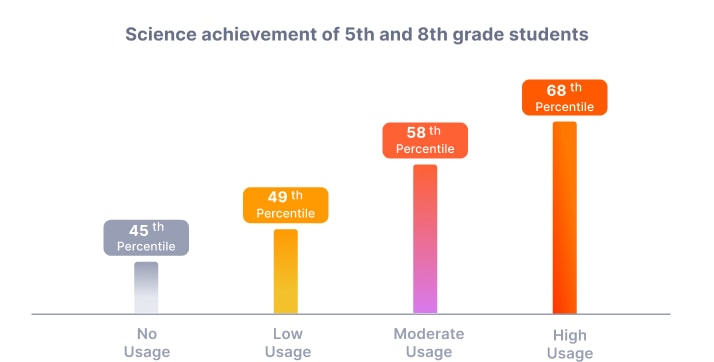
A study by WestEd showcases that game-based learning strategies like the one provided by Legends of Learning are remarkably effective in raising test scores.
In brief, students with high usage (50+ games) experienced a remarkable 25 percentile point increase on their annual science exams. By comparison, those with moderate usage (25-49 games) saw a 13 percentile point increase. Read the full WestEd report.
Involving over 14,500 students, this large-scale study demonstrates that students actively engaged with Legends of Learning games in science classes saw significant gains.
Aligned by design according to state standards and including popular frameworks like Common Core, NGSS, and TEKS, these games, and supplementary resources ensure skills and knowledge gained through gameplay directly contribute to academic success.
Games vs. traditional learning tools, according to Dr. Gee
Games are often more engaging than traditional learning tools because they are fun by design. But how does GBL achieve higher engagement from an educational theory standpoint? Dr. James Paul Gee, a member of the National Academy of Education, attributes the success of GBL partly to the principle of “Performance Before Competence.”
In his work “Good Video Games and Good Learning” he highlights a key difference between traditional and game-based learning (GBL). Traditional methods often follow a “read first, do later” approach, requiring students to grasp a concept fully before attempting related tasks. In contrast, GBL offers “smart tools” embedded within the game itself.
This allows students to “perform before they are competent,” meaning they can actively engage with the material even if they haven’t fully mastered it yet. For many students, this “learn by doing” approach inherent in GBL is far more effective than traditional methods.
Types of game-based learning
Among the advantages of game-based learning, we can include the power to transform classrooms into engaging landscapes for students of all ages. But with so many game options available, educators might wonder: what types of games are most effective for learning?

Board Games
Classic board games like Monopoly can be adapted for educational purposes.
Subjects like history and math can be incorporated with modified rules, or entirely new educational board games can be used.
Hybrid Learning Games
These games combine digital and physical elements, meaning virtual games and material resources.
A classroom might use a digital learning platform alongside physical manipulatives or hands-on activities to create a more engaging learning experience.
Learn more about what hybrid learning is and get to know the benefits that hybrid learning has for educators and students.

Educational Video Games
Strong and modern game-based learning strategies heavily leverage the power of educational video games to create engaging and effective learning experiences.
This broad category encompasses a wide variety of games designed specifically for learning like:
- Simulations: These games allow players to perform specific roles and experience real-world situations. They can be used to teach everything from history and economics to city planning and space exploration.
- Adventure Games: These narrative-driven games often involve problem-solving and exploration. They can be a fun way to learn about history, literature, or science fiction concepts woven into the storyline.
- Arcade-Style Games: Games like fast-paced quizzes or educational racing games can make learning basic concepts like math facts or vocabulary more engaging.
- Educational Apps: These mobile apps often incorporate game elements like points, badges, and leaderboards to make learning interactive and fun. They can cover various subjects and cater to different age groups.
- A powerful mix of all the above in one place: Awakening. A knowledgeverse that blends the immersive simulations of wild exploration with the captivating narratives of learning adventures. Students enjoy playing and learning within the arcade and unlocking badges through challenges, all in one app!
A game-based learning platform for Schools & Districts!
Legends of Learning Platform offers three main game-based learning solutions for schools and districts: Learning Universe, Math Basecamp, and Awakening.
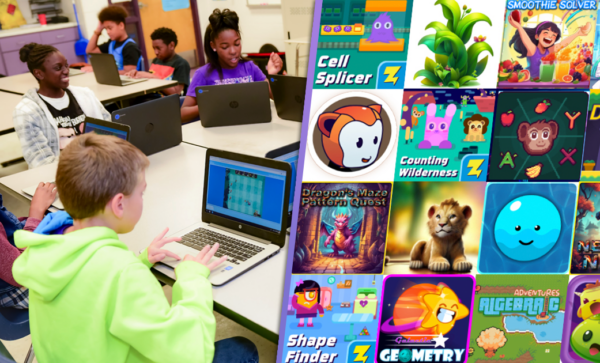
Learning Universe
A one-stop shop for over 2,000 curriculum-aligned math and science mini-games, lessons, and assessments.
These games were designed by world-class studios to be fun, and informative and integrate seamlessly with the existing curriculum.
Legends of Learning partners with world-class global game studios and instructional designers to create these games, ensuring a high-quality experience.
Visit Learning Universe and discover how video games help students reach their full potential! Sign up for free and bring the power of game-based learning to your classroom today!
Math Basecamp
Math Basecamp, a CODiE Award finalist for Best Educational Game, is a program designed to help students master math facts. It uses a personalized approach to identify areas where students need help and tailors practice exercises accordingly. Teachers get real-time data on student progress to identify who needs extra support.
Math Basecamp takes students on a journey to math fact fluency through three key phases:

Fluency Foundation: This phase lays the groundwork for success. Interactive lessons and fun games introduce students to essential math concepts and strategies. They’ll build their understanding of number relationships and practice counting skills through engaging activities.
Math Fact Mastery: Here’s where things get customized! Math Basecamp uses a smart learning engine. This means the program assesses each student’s knowledge and tailors practice exercises specifically for them. Students are challenged with facts they haven’t mastered yet while receiving positive reinforcement for those they’ve already conquered.
Fluency Application: Mastery goes beyond memorization! This phase encourages students to apply the facts they’ve mastered. Engaging activities challenge them to use their knowledge to solve real-world problems. This reinforces fact recall while building problem-solving skills and boosting confidence.
A recent McRel Study showed that completing at least 24 sessions of Legends of Learning’s Math Basecamp significantly increased student scores on California’s Smarter Balanced Mathematics assessment. Read the complete report.
Awakening
Our strongest game-based learning strategy is called Awakening. A CODiE Award finalist for Best Gamification in Learning, this is a multiplayer, student-driven, and teacher-directed learning platform for math and science.
Within the Awakening world, students can compete with friends, customize avatars, and explore a virtual world while playing educational games. Studies have shown that playing Awakening games at least twice weekly contributes to significant achievement gains.
Students conquer math problems, explore scientific concepts, and have a blast doing it. That’s the magic of Awakening, a multi-player world that goes beyond just games – it’s a dynamic universe that transforms education into an engaging adventure.
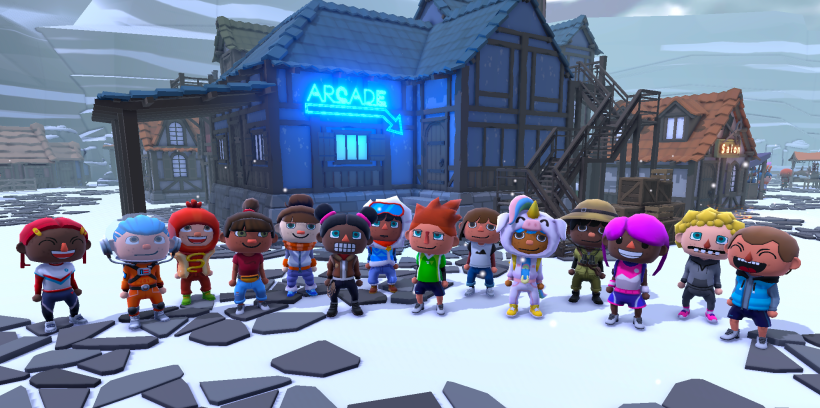
Here’s why Awakening is a game-changer for educators and students:
Fun Meets Learning
Awakening leverages the power of game-based learning, making education intrinsically motivating. Students solve problems, battle Beasties (adorable monster companions!), and compete with friends – all while mastering crucial math and science concepts. It’s a win-win for everyone!
Aligns with Curriculum
Awakening’s Arcade boasts a vast library of over 2,000 curriculum-aligned math and science mini-games. Educators can customize the learning experience by selecting specific grade levels, standards, and subject matter to perfectly complement existing lesson plans.
Student Choice and Personalization
Learning shouldn’t be a one-size-fits-all experience. Awakening offers a vibrant world where students can explore at their own pace. They can design their dream house, compete in educational arcade games, dance with friends, or even explore the uncharted Wilds with an Adventure Pass.
Focused Learning
For dedicated practice, Awakening School and Math Basecamp offer structured environments with interactive simulations, problem-solving exercises, and targeted activities in math and science.
Empowering Learning Styles
Whether it’s friendly competition in the arcade or focused practice in the classroom, Awakening allows students to tailor their gameplay to their preferred learning style.
Self-Expression Meets Education
Awakening fosters individuality. Students can unleash their creativity with a vast selection of avatar clothing and hairstyles, making their learning journey more engaging.
Data-Driven Insights for Teachers
Awakening empowers educators with valuable data. Detailed reports track student progress, highlighting areas of mastery and knowledge gaps. This real-time data allows teachers to personalize instruction and provide targeted support.
This powerful tool ignites curiosity, promotes collaboration, and empowers students to take ownership of their learning journey. From all the advantages of game-based learning strategies, Awakening heavily leverages the power of educational video games to create engaging experiences.
With a research-backed approach, curriculum alignment, and a commitment to student engagement, Awakening can revolutionize how math and science are taught in your school district, raising test scores.
Ready to unleash the power of Awakening in your classrooms? Visit the Legends of Learning website to explore this learning world!
Sign up for free and bring the power of game-based learning to your classroom today!
Check out our latest blogs, articles, and news!
- Step Into the Past: Explore January’s Latest US History Games
- Kick Off the New Year With Fresh Science Learning Games
- New Year, New Math Adventures: Explore January’s Game Releases
- Classroom Tips to Navigate the Holiday Season with Calm and Confidence
- Next Level Learning: How Florida Teachers Are Implementing Game-Based Science Instruction



